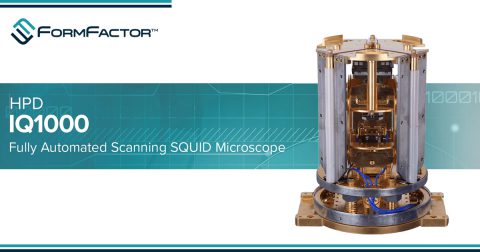We just launched our first product for the emerging quantum computing market – the HPD IQ1000 – a scanning SQUID microscope. Quantum IC designers use this Superconducting Quantum Interference Device tool to study the dynamics of trapped magnetic flux (magnetic vortices) in superconducting circuits which can negatively impact circuit operation.
Companies today avoid the issue of magnetic vortices by operating in an ultra-low magnetic field environment where the vortices are not created. This works for small circuits but it is impractical to maintain the high levels of shielding as quantum technologies scale up. Instead, as quantum computing circuits grow in complexity, engineers must deploy resilient circuit design techniques to trap and nullify these vortices.
The IQ1000 enables superconducting device design teams to image magnetic vortices in devices cooled through the superconducting transition temperature in controlled magnetic fields. With rapid scan speed and process automation, the IQ1000 is the first commercial product of its kind to enable unattended and high-throughput characterization. Device designers can now eliminate the guesswork involved in the design of resilient superconducting circuits, and significantly reduce development time by locating and capturing detrimental magnetic vortices to enhance device performance.
As the quantum industry matures and scales up the number of qubits for commercialization, intelligence to enhance device performance becomes increasingly important. The HPD IQ1000 bridges the gap by providing essential cryogenic system integration and automation, helping superconducting circuit designers to gain advantage over competing qubit implementation technologies.
The IQ1000 is designed for sub-micron resolution imaging at the extreme low temperatures at which superconducting circuits operate. The system can control sample temperature from less than 3 Kelvin to over 20 Kelvin.
The HPD Scanning SQUID Microscope includes:
- Rapid Image Acquisition: Scan speed of up to 100 microns per second, capable of 100 x 100 micron image acquisition in less than two minutes
- High Resolution Imaging: Imaging resolution of 200-500 nanometers (depending upon SQUID sensor used)
- Autotuning: The system autotunes and locks the SQUID magnetic flux sensor system and automatically maintains optimal system tuning
- Unattended operation: All scan procedures can be pre-programmed and run unattended
- Sample size: The system can accommodate samples up to 20×20 mm
- Cryogen-free: The system is cryogen-free and the microscope core is vibration-isolated from the cryocooler.
For additional information, check out the website or download the SQUID Microscope brochure.
